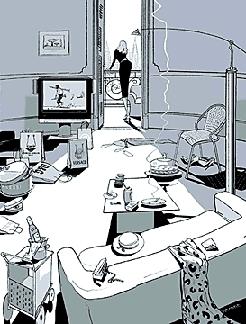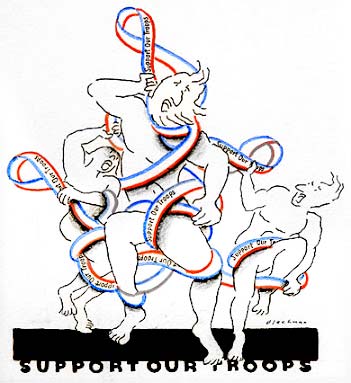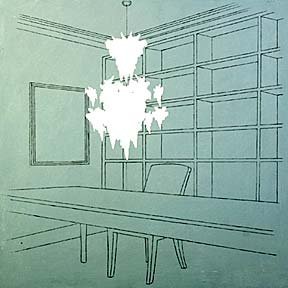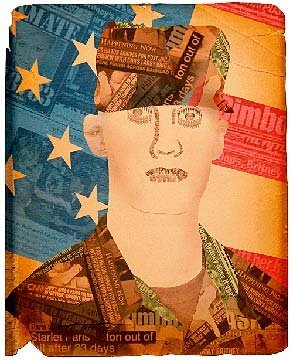Artists Against The War – A Review
To mark the 5th anniversary of the U.S. invasion and occupation of Iraq, Foreign Policy in Focus magazine asked me to write a review of Artists Against The War, an exhibition of antiwar art organized and presented by the New York-based Society of Illustrators. The following article was originally published in FPIF, March 18, 2008.
______________
On May 1, 2003, George W. Bush held an Iraq War victory celebration aboard the aircraft carrier, USS Lincoln, a moment of triumph that has since metamorphosed into the very embodiment of folly as the bloody war continues to grind on. On that faraway date Bush stood beneath a mammoth banner that read, “Mission Accomplished.” Ed Koren has memorialized the event very differently from what the president intended.
The artist has created a sketch titled after that embarrassing banner, but thematically it presents another view of military madness. Drawn in Koren’s characteristically jangly and nervous style, the picture of shell-shocked soldiers on a muddy battlefield strewn with the carnage and ruin of war recalls images from the trenches of World War I. Koren’s nightmarish sketch offers no rationale for the conflict. This inability to grasp the reasons behind the hostilities links the artwork to the incomprehensible brutalities of wars past and present.
Koren’s work is part of an important exhibition put on in January 2008 by the New York-based Society of Illustrators. Titled Artists Against The War, the exhibit took place in the lead-up to the fifth anniversary of the U.S. invasion and occupation of Iraq. It draws from the history of graphic protest and demonstrates the many ways that illustrators—in comics, editorial cartoons, illustrations for magazine articles, and so on, have reflected on the representations and misrepresentations of war.
The history of commercial illustration in the United States encompasses the images of artists like Charles Dana Gibson, Maxfield Parish, N.C. Wyeth, James Montgomery Flagg, Frederic Remington, and Norman Rockwell. These and many other artists helped to shape and define the American experience. After the Second World War, a divide grew between the worlds of illustration and fine art. Commercial publishers bankrolled illustrators to produce images on demand that were essential to marketing. Fine artists, meanwhile, generally struggled on their own to create unique and contemplative works of a decidedly non-mercantile nature.
Early on, some editorial illustrators, while still on paid assignments sponsored by commercial interests, nevertheless managed to bridge this gap between illustration and high art, creating evocative works that told of real world events. For example, the magazine Harper’s Weekly employed Winslow Homer as a war correspondent, sending him to the front lines of the American Civil War to sketch soldiers on the battlefield. Afterwards Homer evolved into one of America’s finest 19th-century painters. Its business related foundations aside, illustration commonly shared with fine art—at least up until the post WWII era—an exploration of the world through the traditions of objective realism. However, the postwar period saw that relationship smashed to smithereens with the ascendancy of abstract art.
The high art world is now in paralysis over its inability to provide thoughtful examinations that connect with broad numbers of people. Surprisingly enough, it might be the world of commercial illustration that offers a model for the advancement of contemporary fine art. Endeavoring to communicate clearly with as wide an audience as possible, illustrators never abandoned realist aesthetics, which are unmistakably the most direct way of delivering a thought or concept to a large audience. Perhaps more importantly, illustration art does not wallow in the cynical disengagement and alienation that is so fashionable in today’s high art, and therein lies the importance of the Society of Illustrators Artists Against The War exhibit.

Istvan Banyai’s The first Casualty of War is Truth is reminiscent of a certain illustration style of the late 1950s and early 1960s: a crisp, detailed draftsmanship and a monochromatic color scheme that focuses on the au courant lifestyles of the privileged. In pencil and digital media, Banyai drew a portrait of one such social butterfly, a fashionable young woman in her ritzy big city apartment.
The linear perspective of the artwork shows us a woman standing on the balcony of her abode, the sunlight that spills into her residence reveals the wake of a recent shopping spree.
The living space is littered with bags and merchandise from big-name posh boutiques. However, social reality is inescapable, and the bourgeois interior is unsettled by the presence of the ubiquitous household television. It broadcasts the image of an Arab guerilla fighter carrying a rocket-propelled grenade.

The design of R.O. Blechman’s Support Our Troops appears to be simple, but its political complexity is undeniable. The artist’s uncomplicated and brilliantly drawn line alludes to the 1st-century Hellenistic Greek statue, Laocoon, now located in the Vatican Museums of Rome. Greek mythology mentions Laocoon as the priest who warned the people of Troy, then under siege by the Greeks, not to bring into their city the gigantic wooden horse found outside the city’s gates.
Laocoon’s cautionary oratory to his people has been passed down to us in the bastardized phrase, “Beware of Greeks bearing gifts.” At the end of his impassioned speech in opposition to dragging the enormous horse into Troy, Laocoon threw his spear at the horse—thus angering the goddess Minerva, who sent two monstrous sea serpents to slay Laocoon and his two sons.
In his artwork Blechman replaces Laocoon and his doomed offspring with contemporary characters who are punished by the Gods of preemptive war for having refused the “WMD” Trojan horse. Instead of being tormented by snakes, the tragic figures are strangled by red, white, and blue ribbons bearing the words “Support our Troops.”

With its flat minimalism, Brian Cronin’s Ghosts harkens back to 1960s Pop Art. But unlike that movement’s impassive and deadpan aesthetics, Cronin’s neo-Pop approach is rich in symbolic meaning and emotional impact.
He presents a nondescript room forlornly decorated with a serviceable but unfilled bookcase, a functional but quite bare table, and an empty frame hanging on the wall. The only suggestion that people once occupied the room is afforded by the radiant chandelier suspended from the ceiling.
But there’s something menacing about that light fixture. Close inspection reveals its luminescent bulbs are in fact the phantasmagorical silhouettes of diminutive jet bombers. Like an ethereal nest of vampires they have sucked the life out of the room. Cronin proffers the conclusion that the absence of books, art, and other vestiges of civilization—as in the real world—can be directly attributed to the unquenchable hunger of the wraithlike war machines. They are the ghosts that have robbed us of our humanity.
Peter Kuper’s 2004 This is Not a Comic (Silkscreen, not pictured), is a hilarious send-up of Ceci n’est pas une pipe (“This is not a pipe”), the famous painting by Belgian Surrealist René Magritte. Kuper constructed a series of comic panels, with the first being Magritte’s pipe and the words, “This is not a pipe.” Subsequent panels present images of war and disaster coupled with words of denial. Jet bombers obliterating human targets combined with the words, “This is not an invasion.” A homeless vet living on the street and begging for food, captioned with the words, “This is not unemployment.” A close-up view of a surveillance camera scanning the public, along with the words, “This is not your concern.”

Koren Shadmi’s Tasting Victory alludes to the famous photograph taken by Alfred Eisenstaedt on August 15, 1945, in New York City.
Eisenstaedt shot his legendary photo of a U.S. sailor grabbing the nearest girl for a kiss, as throngs of jubilant Americans filled Times Square to celebrate Victory over Japan Day (VJ Day), just after the United States dropped the atomic bombs that forced the surrender of Japan.
If Shadmi’s artwork refers to Eisenstaedt’s photo, and by extension the defeat of the Japanese empire—all similarities end there. The illustration catapults the viewer into a world where the doctrine of preemptive war has become the order of the day, and no one is celebrating.
For a number of reasons Burt Silverman’s 1969 lithograph, Eternal Protesters, is reminiscent of the graphic works created by the great German printmaker Käthe Kollwitz. To begin with, Silverman is well versed in the craft of traditional lithography, which his superlative handling of the unforgiving technique clearly shows. But beyond that he has coupled an adroitness at realistic drawing with a keen eye for social observation, which gives the characters in his artwork a timeless visage.

It is just as likely that the young dissenters pictured in the print could have been protesters on the streets of Berlin during the Weimar Republic of Kollwitz’s day, as they might have been demonstrators in some American city during the tumultuous late 1960s.
If it were not for the date of the print’s creation, the activists portrayed could just as well be railing against the current occupation of Iraq.
Ellen Weinstein’s 2007 Camouflage is a close-up portrait of an American soldier, the type of likeness one usually sees on television news broadcasts reporting on U.S. soldiers slain in Iraq or Afghanistan.
Such images are always tragically the same, a gallant warrior in uniform imbued with the virtues of service and self-sacrifice, whose fresh face is unetched by life’s hard lessons—the physiognomy of a soul whose life came to an untimely end.
But Weinstein’s artwork looks beyond facile patriotism to expose an unsettling reality. The soldier’s portrait, including his uniform and the American flag back-drop, are entirely composed of snippets of tabloid press reports trumpeting Britney Spears, Paris Hilton, and other inconsequential celebrities. The collage presents the viewer with a conundrum. Does the camouflage hide a thoroughly narcissistic and debauched society, or does a manufactured culture of distraction mask a deep-rooted militarism?

Yes, we “support our troops,” but we care for our entertainment and pop stars even more. What blinds us to this psychotic behavior is the real camouflage suggested by the collage.
The Artists Against The War exhibition is certainly not without its weaknesses. A few submissions display limitations when it comes to technical ability, clarity, or political imagination. Some works simply attribute the world’s ills to bad leadership (President Bush being a favorite target) rather than offering a critique that questions systemic cause and effect.
But taken as a whole the exhibit is a remarkable display of artists grappling with complex political issues in straightforward and thought-provoking ways that can be understood by all. Art should interact with society. It should prod, stimulate, influence, and ultimately effect transformation, which to a great degree is precisely what the Artists Against The War exhibit has accomplished. Now it’s time for the elite art world to follow suit.

